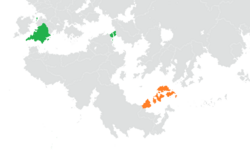Latium-Pulau Relations
 | |
Latium |
Pulau Keramat |
|---|---|
| Diplomatic mission | |
| Embassy of The Latin Emperor, Kopiona Poi | Embassy of Pulau Keramat, Castellum |
| Envoy | |
| Ambassador Marcus Pollius | Ambassador Syariel Shirong |
Latium-Pulau Keramat Relations are most defined by a long period of tension that translates between spheres of influence, commerical exchange, and political wariness that is most accentuated within the Alcaean Straits, spanning from historical interaction between the Tahamaja Empire and the Latin Empire in the early 10th century, to contemporary sociopolitical tensions that emerge largely disparate to ideological conflicts, and moreso over geopolitical identity and regionalistic attitudes. As such, conventional scholars that analyze interactivity between the Kiso Pact and various monarchist elements tend to perceive this tension as existing outside of such a context, and instead utilize analysis of tensions over religion, language, and national attitudes of authority and influence in a strictly bilateral sense.
Whilst the documentation of this oppositon is inherently recorded and analyzed through means of economic competiton and inherited attitudes through both previous Dewan Emas Council Chairs and Latin Monarchs, most contemporarily accenutated through the attitudes of those such as Diane Augusta, no formal modern conflict or cold tension defines the formal relations between the two nations, with a permenant embassy for the new confederation established in 1978, and the Pulaui Embassy being repurposed from its original position in Castellum. Formal relations are kept at a formal minimum of globalized procedure, given the radically deviant political and economic environments between the two nations; however, since the turn of the 21st century, efforts at reconcilliation and a breakdown of tension have been more cognizantly present through the efforts of Template:Constantine XX, as a means of deescalating potential conflict within the area given pressing instability as a result of regional issues such as the Fahrani Civil War, the Template:M'birunan Nkomo Accords, and the Template:Gran Aligonian Crisis.
A majority of interaction between the Pulaui Archipelago and the Empire occur within the proximity of Perateia, giving its boundary position between the Periclean and Ozeros. Political and historical analysists have tied this region as being perceived as the overlap of spheres of influence to both nations; in the historical domineering presence and security ensured by Latin over the Periclean, and the rapid Pulau expansion and unification of the Ozeros through mediums such as the Association of Malaio Ozeros Nations and the Vespanian Exchange Institute. Because of this, periphery nations like Vardana, the Chasanid Empire, and Fahran often see proximity relations in terms of support, influence, and geopolitical engineering as both percieved spheres overlap in the Northern Ozerosi Basin. This interaction has also led to interesting sociocultural diffusion on aspects of religious presence, avenues of commercial exploration, and migratory populations within Perateia.
History
Medieval Cross-Cultural Interactions
Early historical analysis of serious, impactful interaction stems from movement by the Tahamajan thalassocracy into the Periclean after the Asing Mesa Declaration of expansion and exploration. Primarily results of this exchange included the movement of citrus, spices, and fabrics into the Periclean that had not yet been made available, as well as the return of wines, olives, and oils that would be used in substitute to the endemic substances used in Tahamajan Shipbuilding. Given a majority of the early Latinic Empirical rule occurs within the Western corridors of the Periclean, a majority of political interaction at this time was shared with the Vardanan Empire and Bayarid Empire, yet this extension of religious and cultural exchange would remain an influencial part of the Perateian straits, in the establishment of ethnic conclaves and the development of diffusive culinary habits, such as the utilization of 'Sambal' from Pulaui Cuisine in traditional dishes, such as in Gyros, Pizzas, Paellas, and other savory dishes adopted from mainland Latium.
Contemporary Relations
Periclean-Ozerosi Exchange
Commercial Relations
(TBC)
Cultural Relations
(TBC)